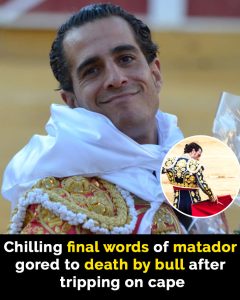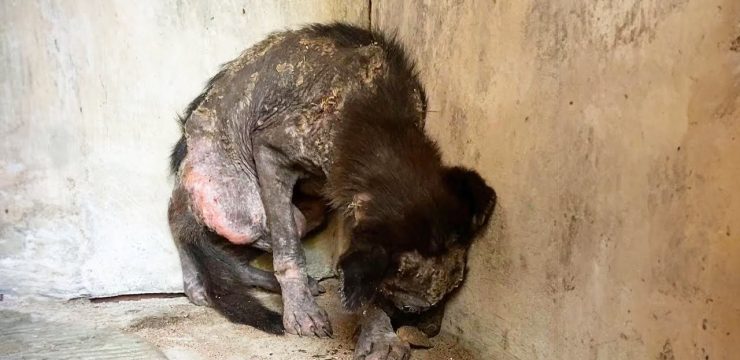Renowned Spanish matador Iván Fandiño met a tragic end in 2017 after being fatally gored by a bull during a bullfighting festival held in Aire-sur-l’Adour, a town in southwestern France. The 36-year-old, widely respected in the bullfighting world for his courage and years of experience, lost his life in an event that shook not only the arena’s spectators but also the global bullfighting community.

Fandiño, a native of Spain’s Basque Country and a proud father, had been involved in professional bullfighting for over ten years. He earned a reputation for confronting bulls that many other matadors considered too aggressive or unpredictable. He wasn’t just a matador; he was a figure known for pushing the limits of bravery and artistry in a tradition as ancient as it is controversial. On the day of the accident, Fandiño had already completed one round in the arena before returning for a second fight.
The tragedy unfolded rapidly. While maneuvering in the ring, Fandiño became entangled in his cape, causing him to trip and lose balance. Before he could recover, the bull charged. The massive animal, weighing close to 1,100 pounds, struck Fandiño forcefully in the chest with its horn. The impact punctured his lungs and other vital organs, resulting in catastrophic internal injuries. Spectators watched in horror as he fell to the ground, the moment quickly turning from a daring display of tradition to a life-and-death emergency.
Despite the severity of his injuries, Fandiño was reportedly conscious as he was lifted from the arena and rushed to a medical facility. Those nearby claimed his final words, uttered in desperation, were, “Hurry up, I’m dying.” These haunting words captured the urgency and heartbreak of the moment. En route to the hospital, Fandiño went into cardiac arrest and passed away, leaving fans and fellow bullfighters in utter disbelief.
Images from previous fights show Fandiño confidently controlling bulls, his posture firm, his expression fierce — the very picture of command and tradition. One such moment from a 2014 bullfight captures the essence of the man who had devoted his life to this dangerous and polarizing art form.
Fellow matador Juan del Álamo, who took over the fight and ultimately killed the bull responsible for the goring, shared his disbelief and sorrow after the incident. “I can’t believe it,” he said. “None of us understand how it could have happened; it was all so fast. The bull knocked him down with its hindquarters, and he fell face down.” His voice, like many others in the bullfighting world, carried the weight of shock and grief.
Although this was the final and most tragic injury Fandiño would sustain, it was not the first time he had been harmed in the ring. In 2014, he was knocked unconscious during a fight in Bayonne, France. A year later, in Pamplona, Spain, he was tossed into the air by a bull in a particularly aggressive attack. But Fandiño always returned to the ring, undeterred, embracing the dangers of his craft. His death marked a sobering milestone: he became the first matador to die in France in nearly 100 years. The last fatality in a French bullring occurred in 1921, when Isidoro Mari Fernando died during a fight in Béziers, as reported by the regional newspaper Sud-Ouest.
Back in Spain, news of Fandiño’s death triggered a wave of tributes and heartfelt condolences. King Felipe VI of Spain honored Fandiño as a “great bullfighting figure,” while then-Prime Minister Mariano Rajoy offered his sympathies to the family. The matador’s passing represented not only a personal loss to those who knew him but also a symbolic moment for Spain’s cultural and sporting history.
What made the timing of Fandiño’s death even more jarring was that it came less than a year after another shocking fatality in the bullfighting world. In 2016, Spanish matador Víctor Barrio was killed during a nationally televised bullfight — the first such death in Spain in over three decades. That tragedy, too, sparked international discussions and debates surrounding the safety and relevance of bullfighting in the modern world.
The centuries-old tradition of bullfighting has long divided public opinion. Supporters argue that it is a cultural heritage worth preserving, a ritual that combines athleticism, art, and courage. Critics, on the other hand, see it as a cruel and outdated spectacle that glorifies animal suffering. Animal rights groups have ramped up their calls for complete bans, citing not only the harm to animals but also the serious risks posed to the matadors themselves.
In France, where Fandiño’s life came to an end, bullfighting was legally recognized in 2012 as part of the country’s regional culture. This legal status allows bullfighting to continue in specific southern areas where the tradition has deep roots. Similarly, in Spain, the practice remains protected by law, with passionate supporters insisting that it represents a core part of the nation’s identity.
Nevertheless, public opinion appears to be shifting. Younger generations, particularly in urban areas, are increasingly rejecting bullfighting, viewing it as incompatible with modern views on animal welfare. At the same time, traditionalists are fighting to keep the practice alive, organizing festivals, schools, and promotional campaigns to educate people about what they see as the beauty and bravery behind the ritual.
Iván Fandiño’s death became more than just another tragic accident in the ring. It reignited debates about the risks taken by those who dedicate their lives to bullfighting and the ethical implications of the sport itself. While some saw him as a martyr for tradition, others viewed his passing as another reason to reconsider the future of bullfighting altogether.
Regardless of one’s stance on the practice, there is no denying that Fandiño’s death left a deep impact. He was a man who lived by the sword, fully aware of the dangers, yet unwavering in his commitment to his art. For his fans, friends, and fellow matadors, Iván Fandiño will be remembered not only for how he died — but for the way he lived, with passion, pride, and fearless devotion to a centuries-old tradition that still stirs the soul.





